Back pain responds well to exercise. The back likes to be moved, it likes to have stress put through it, it likes to do work.
Doing normal things with our backs and not thinking about it is the holy grail of back pain treatments. Sometimes that goal seems rather far away and doing some exercises for our backs can be useful.
Relaxation
Relaxation has been around for ages, but despite modern pain research, we are finding it more and more useful in helping people manage back pain. We are continually bombarded with messages that we need a strong core. Just the word core conjures up ideas of strength and power.
However, research has indicated that people with back pain may have an overactive core rather than an underactive one. So, tensing up and preparing ourselves consciously for doing what we see as a stressful action may be counterproductive.
This tension may amplify our pain mechanisms and give us more pain. This can be quite difficult to spot and you may need a physiotherapist to check your movement techniques to see if you are doing this. Practising relaxation techniques can work well but keeping it up over time is vital so you can apply it in normal day to day life.
The Daily Practice
The daily practice often refers to meditation, exercise, good eating, and good work methods but regularly doing the exercises is the thing here. Keep going until you begin to see changes as it will take some time.
Putting your back through its full range of movement several times every day can help reduce pain, improve range, increase strength and restore some of your normal movement. By preventing stiffness and stretching out all the tissues, it allows you to be more resilient to physical demands.
Disclaimer
If you have any doubts about doing exercises for pain or stiffness or other condition, you should always consult a physiotherapist, other manual therapist or medical practitioner.
Exercises are definitely not a “one size fits all” situation, it is often important to get guidance individualised to your particular circumstances. These exercises shown here do not constitute medical advice and, in some cases, exercise can make your pain worse rather than better.
How to Do the Exercises
The exercises are very simple and not targeted at any specific problem.
If you have chronic (long-term) back pain you may find that the exercises can maintain your movement and use but don’t change your pain much if at all.
Start low by doing one set of five movements and do them slowly and in a relaxed and easy fashion. As you become more confident and don’t react, increase the numbers of sets, the numbers of movements and the times you do them every day. Three times a day, three sets of ten movements would be a good aim with time.
One Leg To Chest
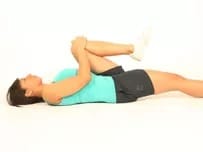
Lying on your back with your legs straight out, take one leg and bend it up to your chest, pulling your knee up to your chest with your hands. Do five times on one send, have a short rest, do the same with the other.
When you pull one leg up, try and keep your other leg flat on the ground. Hold the position at the top of the movement for a second or two each time.
Knee Rolling

Lie on your back with your knees bent up and your feet flat on the surface. Keeping your knees together, roll them to one side and back to the middle. Relax into the movement and allow the range of stretch to increase as you do it. Do one side at a time initially but as you get more confident you can go from one side to the other.
Pelvic Tilting
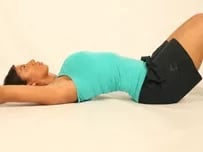
Lie on your back with your knees bent up and your feet flat on the surface. Start by getting the hang of the movement by arching your back off the surface a little. It can be quite difficult to understand what is needed and this movement can be useful to improve bending over in standing later on in rehab.
Remember – if you are uncertain in any way, get advice from your physio, manual therapist or medical practitioner.
I find that many people have real trouble in figuring out just what to do in this movement and just can’t get the hang of it. Adjusting the pelvic tilt in standing can be useful but if you can’t do it in lying you have no chance in standing. Starting the movement by going the opposite way, into back arch, can help get the idea into your head.
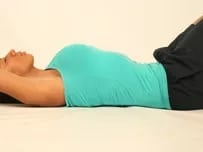
Now press the small of your back down to the surface and tuck your bottom under. Do not lift your buttocks up, this is a forward and back rocking motion and often tricky to get right. You should feel the small of your back has pushed down against the surface. If put your hand under your back when you arch slightly you will feel the pressure as you tilt correctly in the opposite direction. When you get good at this you can use it to control the amount of pelvic tilt you have in your back in standing and to perform the core stability exercises which are thought to play such an important part in back pain related problems these days.
Hip Hitching
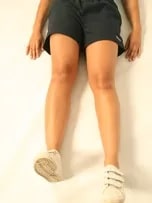
Lie on your back with your legs out straight. Shorten and lengthen each leg alternately, pulling up each side above the hip bones. Do this slowly and smoothly, it can be quite aggravating for the back if you go at it too hard and jerkily.
This exercise is really done from the waist, pulling the pelvis up at each side whilst keeping the knees straight. It’s easy to let the knees bend then this becomes a leg exercise and not a back one. It feels a bit strange and can be a little severe on the back joints so it’s good to go easy. Some people jerk it strongly and I recommend you develop a smooth, easy rhythm for best results.
This pushes and pulls at the range of movement of the small facet joints at each side of the back and can be useful for reducing stiffness in particular.
Both Knees To Chest
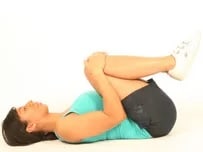
Lie on your back, bend one knee and hold on with the same hand then do the same with the other leg. Pull both legs up towards the chest, gently at first. NB If you have a recent disc problem this can make you worse. If in doubt, get advice.
This exercise can feel very stretchy at first as many of us do not flex our lumbar spines fully in normal life. You may not be able to get your knees up as far as she can but that doesn’t matter to start with. Go as far as you easily can and you will see improvement steadily with time.
Back Arching
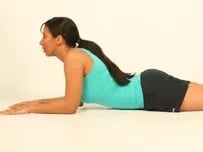
Lie on your front. Get up so you are resting on your forearms, as if you are lying on the beach and looking out to sea, then lie down again.
If you find this difficult you might need to start by just lying on your front for a short period of time for your back to get used to being in extension of some degree.
Your back and hips should be relaxed as you let them go and remain where they want. The only work you are doing is supporting your upper body weight with your arms and shoulders.
Standing Exercises
If you have a long term problem and wish to keep spinal mobility it can be useful to do movements when you may not be willing or able to go somewhere to lie down.
Forward Bending
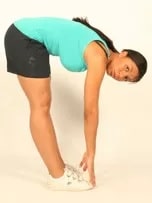
Yes! This is not a dangerous movement and is important to maintain as many of the normal things we do in life require it.
Slowly bend over as if you are trying to touch your toes, then return to the vertical. Don’t bounce, push or hold, just do a smooth movement.
Don’t worry if you do not get anywhere near your knees, it doesn’t matter at all. Regular use of this movement can be very useful to maintain a healthy back as it is one we tend to avoid, especially if we have had back pain problems in the past.
Side Bending

Stand with your hands against the sides of your thighs. Slide one hand down the same thigh, bending to that side and avoiding any twisting, as if you are stuck between two panes of glass.
Do to one side, then give yourself a short rest before doing the other. I find it unpleasant if I go from one side to the other straight away. See how you feel. This can be quite a severe movement so go easy, allowing the range to increase slowly as you do it. It pushes the facet joints of the lumbar spine together and is a somewhat unnatural movement as it tends not to occur on its own.
Arching
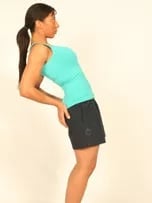
Stand with your palms against your buttocks, as if you are holding on to them. Move your hips forward, then lean back as far as you easily can. This can feel a bit tricky to start with but go easy and you will find it easier with time. This can be a very useful movement to do if you have a disc-related problem and can’t lie down to do prone back extensions (press-ups).
Remember – if you are uncertain in any way, get advice from your physio, manual therapist or medical practitioner.
Last Review Date: 05-02-2019
Next Review Date: 04-08-2020
